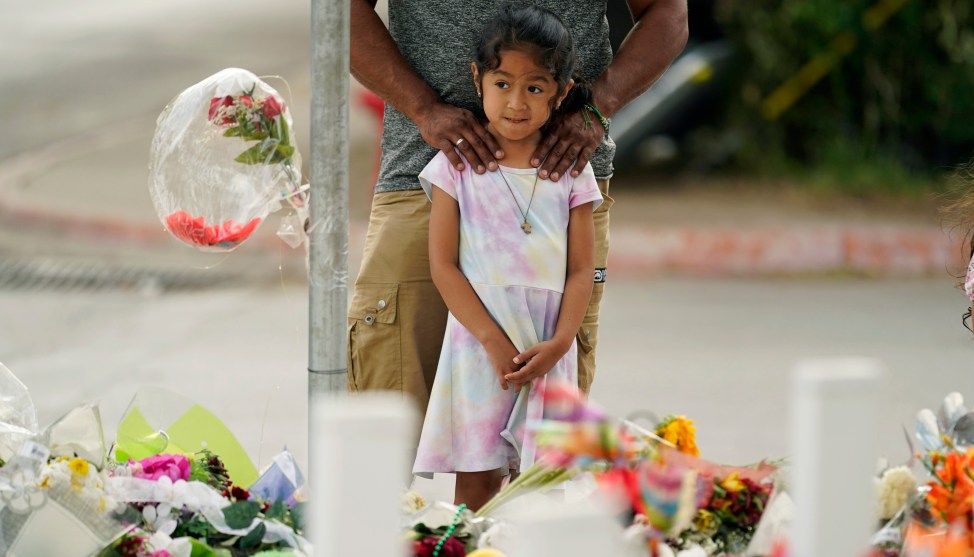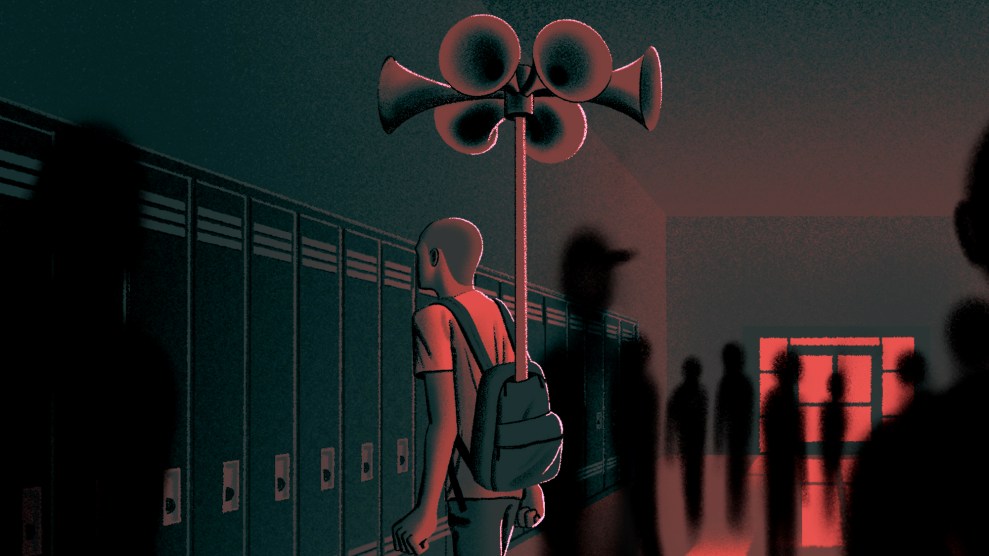
Mother Jones illustration; Getty
The devastating events of May 24 in Uvalde, Texas, are still in some ways hard to fathom. For an unbelievably long hour and 13 minutes, legions of law enforcement officers at the scene failed to stop a gunman who murdered 19 children and two teachers inside Robb Elementary School. Police eventually entered the classroom where the 18-year-old perpetrator was hunkered down amid the dead and dying and ended his life in an exchange of gunfire.
The slow, confused, and ineffectual response undoubtedly worsened the toll, which included dozens of others injured and traumatized. That catastrophic breakdown remains subject to multiple state and federal investigations and the acute sorrow and outrage of the public. Such intense focus makes obvious sense—and yet, thus far, it has obscured another part of the story that is profoundly tragic. The Uvalde massacre never should have happened at all. It could have been prevented long before the perpetrator spiraled deep into crisis and planned and prepared extensively for his attack.
The emerging case background already makes that reality clear, marked by an array of long-accumulating warning signs from the shooter. They are detailed in a 77-page report published in mid-July by a fact-finding committee from the Texas House of Representatives, though this fuller picture, which goes well beyond what was indicated by news reports in the immediate aftermath, has received little attention.
It’s important to acknowledge some key caveats: The red flags that precede virtually every mass shooting of this kind are inevitably easier to see in hindsight. Usually they are most noticeable to people close to the perpetrator, yet it’s also essential to avoid presumptuously assigning blame, particularly in the early stages of an investigation. The facts invariably are complicated when it comes to questions about family members, peers, or others who may have been aware of the potential for violence and may not have known what to do or felt inhibited for various reasons about seeking help.
But a troubled person’s often lengthy pathway to attack—and potential opportunities to intervene along the way—can also be understood clearly through the research and case work of behavioral threat assessment. In Trigger Points, my recently published book about preventing mass shootings, I detail eight broad areas of warning signs that threat assessment teams rely on to evaluate and intervene with dangerous individuals who are mired in rage, despair, and other problems and frequently turn suicidal. The method has been used to remarkable effect with constructive interventions by teams throughout the country, as I chronicle in the book.
The outcome of warning signs unheeded is, fundamentally, always the same story. Look no further than the recent mass shootings at Oxford High School in Michigan, the Tops supermarket in Buffalo, New York, and the July 4 parade in Highland Park, Illinois. The detectable behaviors and circumstances leading up to the massacre by 18-year-old Salvador Ramos in Uvalde check all the boxes, too. They range from threatening communications and emulation of previous attackers, to personal deterioration, triggering events, and, finally, methodical preparation for the attack.
The Texas House report’s discussion of the Uvalde shooter’s background draws on law enforcement investigations, school and court records, the perpetrator’s digital media activity, and interviews with family members, educators, and other witnesses. Situated in the middle of a document that itself focuses predominantly on failures of physical school security and police response, it reveals an excruciating story.
The report indicates that Ramos struggled from his early childhood: He suffered from a speech impediment and conditions of poverty and instability at home. He was identified as “at risk” academically by third grade and experienced bullying in elementary school. He harbored bad memories of fourth grade in particular, according to the report, and it was in his former fourth-grade classroom where he eventually committed the mass shooting. By middle school, he was frequently absent, and by 2021, at age 17, had only completed ninth grade. Uvalde High School withdrew him involuntarily in October 2021, citing poor academic performance and lack of attendance.
As peers were returning to school in 2021 after remote learning during the pandemic, Ramos was headed down a darkening path of personal pain and disconnection, the report shows. “While in earlier years, notes in his phone reflect that he unsuccessfully sought to fit in (including a fixation with weight and fitness that resulted in an eating disorder), in 2021 he appears to have increasingly withdrew and isolated himself.”
A relationship Ramos had with a girlfriend ended in mid-2021; she told the FBI that he became lonely and depressed and was “constantly teased by friends who called him a ‘school shooter.’” She said that Ramos “told her repeatedly that he wouldn’t live past eighteen, either because he would commit suicide or simply because he ‘wouldn’t live long.’”
Ramos responded to the breakup by harassing the girl and her friends, according to the report. He began wearing black clothes and combat boots and was active on social media and gaming platforms. “Most of his usernames and even his email address reflected themes of confrontation and revenge,” the report says. His behavior included violent misogyny, a significant factor in mass shootings:
The attacker began to demonstrate interest in gore and violent sex, watching and sometimes sharing gruesome videos and images of suicides, beheadings, accidents, and the like, as well as sending unexpected explicit messages to others online. Those with whom he played video games reported that he became enraged when he lost. He made over-the-top threats, especially towards female players, whom he would terrorize with graphic descriptions of violence and rape.
He expressed to others that his TikTok and YouTube channels made him “famous,” and he spoke “enviously,” according to the report, of the publicity that a murderer and animal abuser had gotten as the subject of a Netflix documentary.
Ramos also developed a fascination with school shootings and made no secret of that interest on social media. His disturbing behavior continued to escalate and included a video he shared online in late 2021 that showed him “driving around with ‘someone he met on the internet’ holding a clear plastic bag that contained a dead cat, which he discarded in the street and spit on while his driver laughed.” Animal cruelty is a common warning behavior among mass shooters. Ramos also wore a tactical vest in that video and would later do so during the attack on Robb Elementary, indicative of a rising trend in shooters using tactical gear and body armor.
His further warning behaviors weren’t only displayed online. Starting in late 2021, Ramos held two short-lived jobs at fast-food restaurants, where coworkers regarded him as troubling and hostile; he was fired from the first job after just a month for threatening a female coworker.
He lived at home and “hoarded” his money, according to the committee’s report, telling acquaintances that he was “saving for something big” and that they would see him on the news one day. Family members believed he was saving money for his own apartment or car. In fact, he was focused on purchasing tactical gear and guns.
This was the beginning of a period of intensifying planning and preparation, a pattern of escalating activity that precedes most mass shootings. Since Ramos was still only 17, he asked at least two people to buy guns for him. Those individuals, who are not identified in the report, refused. Beginning in February 2022, he was able to buy accessories, including “60 30-round magazines, a holographic weapon sight, and a Hellfire Gen 2 snap-on trigger system.” (The report does not specify where he bought these.) Investigators determined that family members and friends were aware of his efforts to buy guns.
Soon, he would legally purchase a whole arsenal himself.
By early this year, after further hostilities with his mother, Ramos had left home and moved in with his grandmother, who had retired from working in the local school district after 27 years. (Ramos shot and wounded her shortly before the attack on the school.) The house was just blocks from Robb Elementary. He may have surveilled the school on March 23, according to the committee’s report: A suspicious person dressed in all black with a backpack was seen canvasing the school that day, but no one ever identified the person.
The last time his father saw Ramos, about a month before the attack, he noticed cuts on his son’s face that appeared to be self-inflicted—signs of self-harm that other unidentified witnesses had noticed from Ramos previously, according to the report.
On May 16, the day Ramos turned 18 years old, he began buying firearms and a lot more ammunition. After the massacre, the national political debate over gun laws included calls for raising the legal age-minimum for purchases to 21. Yet, despite the fact that two major mass shootings had been carried out by 18-year-old perpetrators within a span of just 10 days in May, Congress rejected that policy in the bill that ultimately became law in late June. That outcome—as well as continued hostility toward red flag laws from Texas politicians—seems all the more striking in light of the highly lethal weapons that Ramos quickly amassed:
An online retailer shipped 1,740 rounds of 5.56mm 75-grain boat tail hollow point to his doorstep, at a cost of $1,761.50. He ordered a Daniel Defense DDM4 V7 (an AR-15-style rifle) for shipment to a gun store in Uvalde, at a cost of $2,054.28. On May 17, 2022, he bought a Smith and Wesson M&P15 (also an AR-15-style rifle) at the same store in Uvalde, at a cost of $1,081.42. He returned the next day for 375 rounds of M193, a 5.56mm 55-grain round with a full metal jacket, which has a soft core surrounded by a harder metal. He returned again to pick up his other rifle when it arrived on May 20, 2022, and he had store staff install the holographic sight on it after the transfer was completed.
The owner of the gun store described him as an “average customer with no ‘red flags’ or suspicious conditions,” according to the report, but said that he was “always alone and quiet.” A store patron who’d seen Ramos told the FBI that in hindsight, Ramos “appeared odd and looked like one of those school shooters”; another described having gotten “bad vibes” from his all-black attire.
After the massacre, media attention was riveted on Ramos’ violent and disturbing online posts, including his threats against women and the images of his new rifles that he’d posted, along with various comments he made apparently hinting at his intentions. That was only part of the final escalation.
He collected news stories and information about the mass shooting in Buffalo that took place on May 14, two days before his birthday. He soon confided in an older cousin who was also staying at his grandmother’s house, telling her that he did not want to live anymore. (The cousin and an uncle had heart-to-heart conversations with him, and the cousin believed that she’d “gotten through to him,” according to the report.)
In the final days, he engaged in chilling preparation of another kind:
He also spent time with his cousin’s son, who attended Robb Elementary. After playing the children’s videogame Roblox, the attacker elicited from him details about his schedule and how lunch periods worked at the school.
While prevention clearly was not a focus for the Texas House committee, it’s notable that the word “prevention” appears only twice in the entire 77-page report and only generically in reference to the potential for such policy consideration by others.
The report does note that, per Texas legislation enacted in 2019, the Uvalde school district had adopted a “viable” policy for “responding to an active shooter emergency.” That included threat assessment protocols, according to the Uvalde policy: “Every campus employs an interdisciplinary team of trained professionals that convene to identify, evaluate, classify and address threats or potential threats to school security. Following assessment, this team determines appropriate response and intervention. This includes notification and involvement of parents, a suicide risk assessment, and the development of a written safety plan.”
Ramos had no criminal record and was no longer enrolled in Uvalde High School as of about seven months before his attack. It is unclear whether he was previously the subject of a threat assessment investigation, and, if so, how his case was handled. A spokesperson I reached with the Uvalde school district declined to comment.
Those are key questions, however, that the public should want answered amid further investigation of this horrific tragedy—one that was both long in the making and preventable.













